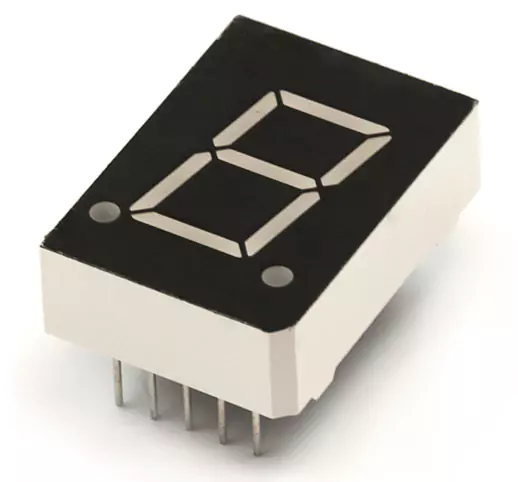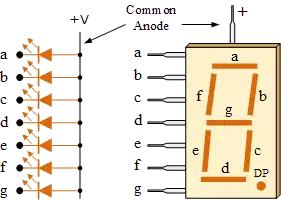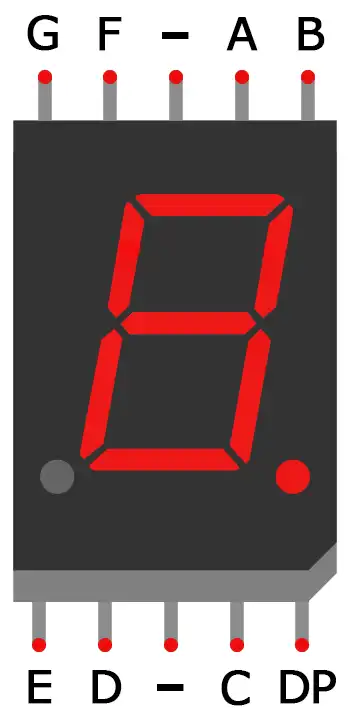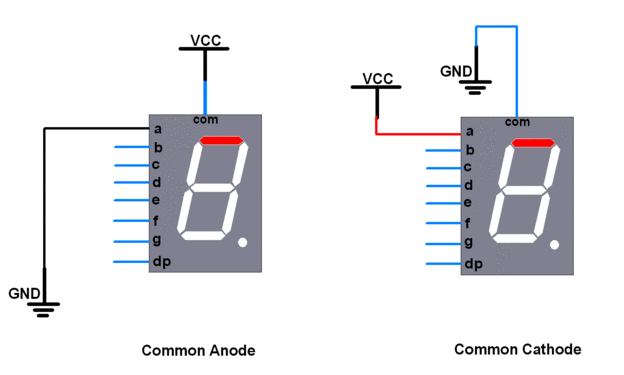7 segment LED Display
A 7 segment LED display is a form of an electronic display device is used for displaying decimal numerals. It is an alternative to previously used more complex dot matrix displays.
Electronic meters, digital clocks, simple calculators, and other electronic devices that display numerical data are the primary applications for 7-segment displays.
Related Article:- 7 Segment Display with Arduino
7 Segment LED Display consists of seven LEDs arranged in a rectangular fashion as shown. Each of the seven LEDs is called segment because when illuminated, the segment forms part of a numerical digit (of both Decimal and Hex) to be displayed.
An additional 8th LED displays the indication of a decimal point(DP). To display numbers greater than ten two or more 7-segment displays are connected together.

Types of 7 Segment LED Displays
When it comes to 7 Segment LED Displays, there are various types available to suit different needs and preferences.
Every LED display has two connecting pins, are “Anode” and “Cathode”, therefore two types of LED 7-segment display called: Common Cathode (CC) and Common Anode (CA).
Usually, you can tell what kind of 7-segment display it is by looking at its common pins.
Additionally, there are various colors available for 7 Segment LED Displays such as red, blue, green, yellow, and white. Each color has its own unique visual impact and applications.
Common Cathode (CC)
In the common cathode display, all cathode connections of the LED segments are connected together to logic “0” or ground. The individual segments illuminate by applying a logic “1” or “HIGH” signal via a current-limiting resistor to forward bias the individual anode terminals (a-g).

Common Anode (CA)
In the common anode display, all anode connections of the LED segments are joined together to the logic “1”. To illuminated every individual segment apply a ground, logic “0” or “LOW” signal via a suitable current limiting resistor to the Cathode of the particular segment (a-g).

7 Segment Display Pinout
A Seven Segment display has 10 pins which are A, B, C, D, E, F, G, DP, and two — pins.

7 Segment LED Display working
7 Segment LED displays work by using individual LEDs arranged in the shape of a numeral “8”. Each segment illuminates or turns off to create different numbers from 0 to 9. You can display various alphanumeric characters by selectively activating these segments.
Behind the scenes, a decoder circuit translates input signals into specific patterns that illuminate the corresponding segments. This process happens rapidly, creating the illusion of continuous display.
The simplicity and efficiency of 7 Segment LED displays make them popular for showcasing numerical information like time, temperature, or scores. Their bright illumination and high contrast ensure visibility even in bright environments.

Display Driver
Usually, a special type of integrated circuit (IC), commonly known as a 7-segment decoder/driver, like the CMOS 4511, drives 7-segment displays.
This 7-segment display driver, known as a Binary Coded Decimal (BCD) to 7-segment display decoder and driver, can illuminate both common anode or common cathode displays.
But there are many other single and dual display drivers available such as the very popular TTL 7447, SN7446AN.
Why use Display Driver?
- The display driver requires only 4 pins of the microcontroller to drive a 7-segment display.
- We do not need to convert decimal numbers into 7 segment display format (from 0-9). We just need to provide BCD (Binary Coded Decimal) numbers and it will take care rest of the seven-segment conversion.
- You don’t need an external resistor.
- It makes easy to interface with a microcontroller.
Advantages and Disadvantages of Using a 7 Segment LED Display
When it comes to using a 7 Segment LED display, there are several advantages worth considering.
- One of the main benefits is their simplicity and ease of use. These displays are straightforward to implement and can communicate information clearly with their segmented design.
- Additionally, 7 Segment LED displays boast high visibility, showcasing bright, crisp characters easily discernible from a distance. This makes them ideal for applications where readability is crucial.
- On the flip side, one disadvantage of 7 Segment LED displays is their limited versatility. Due to their segmented nature, these displays may not be as flexible in displaying complex graphics or images compared to other types of displays.
- Another drawback is power consumption. While LED technology is generally energy-efficient, running multiple segments simultaneously on a 7 Segment display can consume more power than some other display options available on the market.